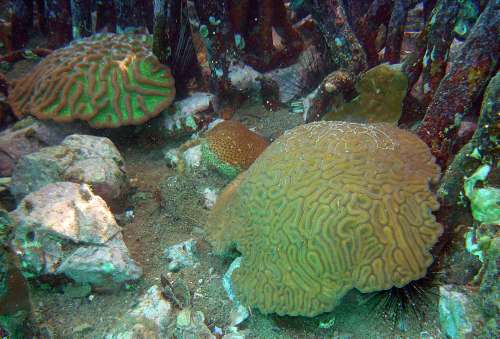Mangroves Protecting Corals from Climate Change

Boulder brain corals, for example, were found in abundance under the mangroves and were healthy, while many of those in unshaded areas a short distance away were bleaching. Photo Credit: Caroline Rogers, USGS
Certain types of corals, invertebrates of the sea that have been on Earth for millions of years, appear to have found a way to survive some of their most destructive threats by attaching to and growing under mangrove roots.
Scientists with the U.S. Geological Survey and Eckerd College recently published research on a newly discovered refuge for reef-building corals in mangrove habitats of the U.S. Virgin Islands. More than 30 species of reef corals were found growing in Hurricane Hole, a mangrove habitat within the Virgin Islands Coral Reef National Monument in St. John.
Corals are animals that grow in colonies, forming reefs over time as old corals die and young corals grow upon the calcium carbonate or limestone skeletons of the old corals. Coral reefs make up some of the most biologically diverse habitats on Earth, and face many threats such as coastal pollution, dredging and disease. However, some of their most widespread threats involve warming ocean temperatures, solar radiation and increased ocean acidification.
It is from these threats that corals are finding refuge under the red mangroves of Hurricane Hole. Red mangroves, subtropical or tropical trees that colonize coastlines and brackish water habitats, have networks of prop roots that extend down toward the seafloor, and corals are growing on and under these roots.
How does it work?
Mangroves and their associated habitats and biological processes protect corals in a variety of ways.
- The shade provided by mangroves protects the corals from high levels of solar radiation. This in turn, may reduce some of the stress caused by warming ocean waters.
- A combination of chemical, biological and physical conditions around the mangrove habitats helps protect the corals by keeping acidity in the water below harmful levels. With oceans becoming more acidic due to the increased amount of carbon dioxide absorbed from the atmosphere, ocean animals like corals are threatened by rising acidity levels, which can slow coral growth and impact reef structure.
- The shade provided by the mangroves helps deter coral bleaching, a condition that essentially starves coral and can, in prolonged cases, result in their death. With climate change, coral bleaching episodes are becoming more frequent around the world.
Bleaching occurs when corals lose their symbiotic algae. Most corals contain algae called zooxanthellae within their cells. The coral protects the algae, and provides the algae with the compounds they need for photosynthesis. The algae, in turn, produce oxygen, help the coral to remove waste products, and, most importantly, provide the coral with compounds the coral needs for everyday survival. When corals are under prolonged physiological stress, they may expel the algae, leading to the condition called bleaching.
When examining corals for this study, researchers found evidence of some species thriving under the mangroves while bleaching in unshaded areas outside of the mangroves. Boulder brain corals, for example, were found in abundance under the mangroves and were healthy, while many of those in unshaded areas a short distance away were bleaching.
Adapting to Climate Change?
Organisms throughout the world are threatened as climate and other conditions change. If they can find ways to adapt, as it appears these coral have, they can continue to survive as part of an invaluable piece of this world’s intricate ecological puzzle. It is not known how many other mangrove areas in the world harbor such a high diversity of corals, as most people do not look for corals growing in these areas. No coral reefs have been identified to date that protect from rising ocean temperatures, acidification and increased solar radiation like these mangrove habitats in St. John.
Media Contact
All latest news from the category: Earth Sciences
Earth Sciences (also referred to as Geosciences), which deals with basic issues surrounding our planet, plays a vital role in the area of energy and raw materials supply.
Earth Sciences comprises subjects such as geology, geography, geological informatics, paleontology, mineralogy, petrography, crystallography, geophysics, geodesy, glaciology, cartography, photogrammetry, meteorology and seismology, early-warning systems, earthquake research and polar research.
Newest articles

Largest magnetic anisotropy of a molecule measured at BESSY II
At the Berlin synchrotron radiation source BESSY II, the largest magnetic anisotropy of a single molecule ever measured experimentally has been determined. The larger this anisotropy is, the better a…

Breaking boundaries: Researchers isolate quantum coherence in classical light systems
LSU quantum researchers uncover hidden quantum behaviors within classical light, which could make quantum technologies robust. Understanding the boundary between classical and quantum physics has long been a central question…

MRI-first strategy for prostate cancer detection proves to be safe
Active monitoring is a sufficiently safe option when prostate MRI findings are negative. There are several strategies for the early detection of prostate cancer. The first step is often a…



